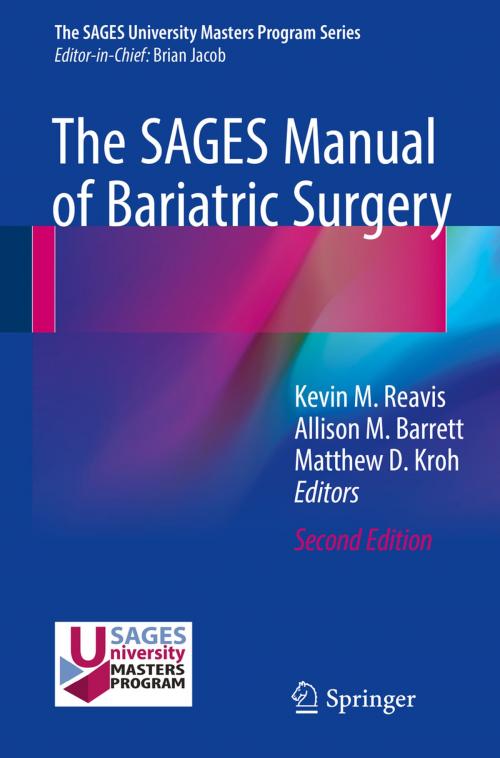The SAGES Manual of Bariatric Surgery
Nonfiction, Health & Well Being, Medical, Surgery, Colon & Rectal| Author: | ISBN: | 9783319712826 | |
| Publisher: | Springer International Publishing | Publication: | April 4, 2018 |
| Imprint: | Springer | Language: | English |
| Author: | |
| ISBN: | 9783319712826 |
| Publisher: | Springer International Publishing |
| Publication: | April 4, 2018 |
| Imprint: | Springer |
| Language: | English |
Morbid obesity is an epidemic as more than 2/3 of the United States population is obese and as such, has a high burden of weight-related co-morbid diseases. Bariatric surgery has proven to be effective and durable for treatment of severe obesity. Technological advances including applications of laparoscopy and endolumenal techniques have rapidly advanced this field. Data and outcomes examining treatments have also improved and as providers, we have a wide spectrum of therapeutic options to treat patients.
As techniques and outcomes have evolved, access to a comprehensive yet focused resource regarding bariatric surgery is currently limited. The proposed textbook is designed to present a comprehensive and state-of the-art approach to the current and future status of Bariatric interventions, which has changed significantly since the first edition of the Manual. Updates in this version will include the rapidly expanding field of endoluminal bariatric procedures, with a focus on new devices and theories of mechanisms. New data regarding laparoscopic approaches to treat obesity, as well as improved longer-term data outcomes will be reviewed. Newer surgical approaches to treat metabolic disease and obesity are included, as well as proposed mechanisms of action and efficacy. Additional new sections include sections on the application of robotic technologies, special circumstances including transplantation and pregnancy, and telemedicine and social media in bariatric surgery.
Sections will address the evolution in specific treatments available to patients, initial evaluation and selection of procedures for individual patients, the latest surgical and endoscopic techniques being employed to treat patients including data on outcomes, and future directions for therapy. In particular and unique amongst references, a major focus of this text will be on both the bariatric and metabolic bases of therapies and outcomes.
The SAGES Manual A Practical Guide to Bariatric Surgery, Second Edition aligns with the new SAGES UNIVERSITY MASTERS Program. The Manual supplements the Bariatric Surgery Pathway from Competency to Proficiency to Mastery. Whether it’s for Biliary, Hernia, Colon, Foregut or Bariatric, the key technical steps for the anchoring bariatric procedures are highlighted in detail as well as what the reader needs to know to successfully submit a video clip to the SAGES Facebook Channels for technical feedback. Readers will also learn about how to count credits for Bariatric from the other Master Program Series, Guidelines, Top 21 Videos, Pearls, FLS, FES, FUSE, SMART and Annual SAGES Meeting. The Masters Program promotes lifelong deliberate learning.
Morbid obesity is an epidemic as more than 2/3 of the United States population is obese and as such, has a high burden of weight-related co-morbid diseases. Bariatric surgery has proven to be effective and durable for treatment of severe obesity. Technological advances including applications of laparoscopy and endolumenal techniques have rapidly advanced this field. Data and outcomes examining treatments have also improved and as providers, we have a wide spectrum of therapeutic options to treat patients.
As techniques and outcomes have evolved, access to a comprehensive yet focused resource regarding bariatric surgery is currently limited. The proposed textbook is designed to present a comprehensive and state-of the-art approach to the current and future status of Bariatric interventions, which has changed significantly since the first edition of the Manual. Updates in this version will include the rapidly expanding field of endoluminal bariatric procedures, with a focus on new devices and theories of mechanisms. New data regarding laparoscopic approaches to treat obesity, as well as improved longer-term data outcomes will be reviewed. Newer surgical approaches to treat metabolic disease and obesity are included, as well as proposed mechanisms of action and efficacy. Additional new sections include sections on the application of robotic technologies, special circumstances including transplantation and pregnancy, and telemedicine and social media in bariatric surgery.
Sections will address the evolution in specific treatments available to patients, initial evaluation and selection of procedures for individual patients, the latest surgical and endoscopic techniques being employed to treat patients including data on outcomes, and future directions for therapy. In particular and unique amongst references, a major focus of this text will be on both the bariatric and metabolic bases of therapies and outcomes.
The SAGES Manual A Practical Guide to Bariatric Surgery, Second Edition aligns with the new SAGES UNIVERSITY MASTERS Program. The Manual supplements the Bariatric Surgery Pathway from Competency to Proficiency to Mastery. Whether it’s for Biliary, Hernia, Colon, Foregut or Bariatric, the key technical steps for the anchoring bariatric procedures are highlighted in detail as well as what the reader needs to know to successfully submit a video clip to the SAGES Facebook Channels for technical feedback. Readers will also learn about how to count credits for Bariatric from the other Master Program Series, Guidelines, Top 21 Videos, Pearls, FLS, FES, FUSE, SMART and Annual SAGES Meeting. The Masters Program promotes lifelong deliberate learning.















